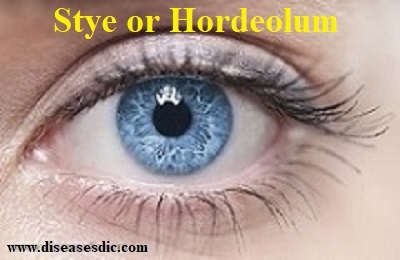Definition
Stye is the painful bump that forms inside or outside of the eyelids. Your eyes have lots of tiny oil glands around the eyelids. Sometimes these tiny glands get blocked and form red bumps. Frequently the bacteria will enter into the bump and causes swelling, inflammation, pain, and redness of surrounding eyelid. It is medically termed as hordeolum. The bump may point out externally or internally and appears like whitish or yellowish or like a large pimple. It infection will get disappears by itself when the blockage in glands gets opened and the infection will go away when the pus is drained from the stye.
Stye or Hordeolum
Epidemiology
No data are available on the incidence and prevalence of hordeola internationally. However, hordeola are among the most common eyelid lesions in clinical practice.
Race
There is no known racial predilection for developing hordeola.
Sex
There is no sexual predilection for developing hordeola. Both men and women seem to be equally affected.
Age
Hordeola are more common in adults than in children, possibly because of a combination of higher androgenic levels (and increased viscosity of sebum), higher incidence of meibomitis, and rosacea in adults. However, hordeola can occur in children.
Types of Stye
There are two different types of stye. Each has different causes. The two types are
Hordeolum: It is the blockage in the sweat gland, which is present in the skin of the eyelid and also in the eyelashes or one of the sebaceous gland that is found on the underneath of the eyelashes. Sebaceous gland is attached to the eyelash follicles that produce sebum which acts as a lubricant for eyelashes and prevent from drying out.
Chalazion: In this type blockage occurs in Meibomian glands, which are the special oil glands in the eyelids. It may cause chronic granulation in the formation of painless lump. These glands form a single row in each lid, with the body of the gland located inside the eyelid, and the opening located at the rim of the lid, posterior to the lashes.
Chalazion
An illustration shows two types of styes
Risk factors
Some of the risk factors for stye include:
- Using expired cosmetics
- Sleep deprivation
- Not removing eye makeup for over a night
- Inserting eye lens without disinfecting with washing solution or not washing your hands when placing your lens
- Touch your eyes without washing your hands
- Have any chronic inflammation in the edge of the eyelids such as blepharitis
- Having skin condition such as rosacea
Causes of Stye
- Stye is usually caused by the infections in the oil gland of the eyelids. It is mainly infected by most common bacteria It causes painful lumps with pus inside in it
- Sometimes it is caused by thickening of the substance which is produced by the gland and causes the substance to flow slowly or not at all
Symptoms
Sometimes stye occurs simultaneously in both the eyes or in one eye. The patient will have a bump, redness or swelling can make your eyes to tear. Symptoms of stye include:
- Blinking of eye due to foreign sensation in eye
- Presence of lump or bump in the eyelids
- Pain in the area of bump
- Swelling
- Droopy eyes
- Discharge of mucus from eye
- Tearing
- Discomfort when blinking
- Feeling that there is a dust in eyes
- Itching of eyes
- Burning sensation
- Blurred vision
Complications of Stye
Complications can be extremely rare, but sometimes complications may occur such as follows:
Chalazion or Meibomian cyst: if you have long-term lumps inside of your eye, it may lead to Meibomian cyst. These lumps are painless unless they get infected.
Periorbital cellulitis: This can cause inflammation around the eyes due to the infection in the lumps. The skin layer around the eye becomes inflamed, red and swollen.
Diagnosis and test
- Your doctor will a perform physical examination on the eye and ask about your symptoms
- Biopsy can be carried out to check for the cause of infection and to remove lumps of the eyelids
Treatment and medications
In many cases stye doesn’t require treatment, it heals by itself. Sometimes it may occur again. Your doctor may recommend following treatments, such as:
Antibiotics: Occasionally your doctor may recommend an erythromycin ophthalmic ointment and other antibiotics such as chloramphenicol or amoxicillin may also be used.
Warm compress: It can also treat your stye. A cloth is warmed with hot water and it gently compressed on the eyes for 5 to 10 minutes. Repeat this for 3 to 4 times a day, it will clear your stye and this makes pus to drain away.
Surgery: If stye doesn’t respond to any kind of therapy, your doctor may recommend a surgical procedure to remove the stye under the local anesthesia. A cut is made; the pus is drained out of the gland. Sometimes the removed stye is sending for the test to investigate the possibilities of skin cancer.
Prevention of Stye
- Wash your hands with sanitizer or soaps for several times
- Use valid, unexpired cosmetics and don’t share cosmetics with others
- Before placing contact lenses in eye, make sure that you washed with disinfectant
- If you have stye already, apply warm compress in the eye. This prevents it from stye coming back
- Sharing towels should be avoided to prevent the infections
- Remove makeup in eyes before bedtime

